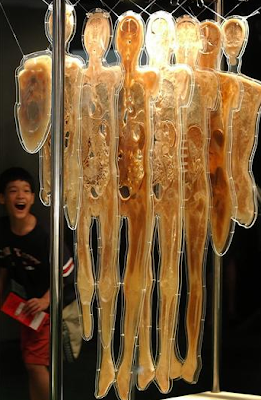Containing about twenty bodies in total, each exhibition uses real human bodies that have been preserved permanently by a process called "polymer preservation" so that they will not decay.
The company received the cadavers for research from the Chinese government, who donated them because all the bodies at the time of death allegedly had no close next of kin or immediate families to claim the bodies.
One section includes several fetuses in various stages of development. Guests are notified by a small sign at the exhibit of the sensitivity of the fetus gallery just before entrance into the area. Guests are also given an option to skip that room if so desired.
Some of the specimens are arranged so that they are performing activities such as playing poker or conducting an orchestra. Along the way are other displays showing a human intestine stretched out, the polluted lung of an adult smoker, and all of the arteries and veins without the body itself. The exhibit of the polluted lung of the smoker also includes a clear standing box in which guests can discard their cigarettes and tobacco products after viewing the display.
Cross section of a human body is displayed in the "Wonders of the Human Body Exhibition" in Hong Kong.
Photo shows muscle structure of a human body in the "Wonders of the Human Body Exhibition" in Hong Kong.
Shows human embryo specimens displayed in the "Wonders of the Human Body Exhibition" in Hong Kong, south China.
Is an educational exhibit that is intended to provide audiences with a unique and visually-informative perspective on the inner working of the human body by viewing real human specimens, preserved through a method called plastination
During the process of plastination, all the water in the body (water comprises about 70 percent of all cells) is replaced by polymers such as silicone rubber or polyester resin that retain all tissue structure via a special vacuum process. The technique can take up to 5,000 hours for a full-body plastinate.
Gunther von Hagens himself said that he had discovered a method of plastination accident. In 1977, he worked as an assistant in the Anatomical Institute at Heidelberg University, and when he oversaw the production of anatomical preparations, he got the idea did not fill their polymer and injected into the polymer.

















